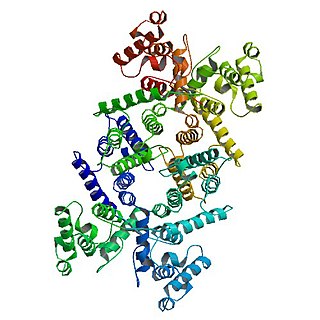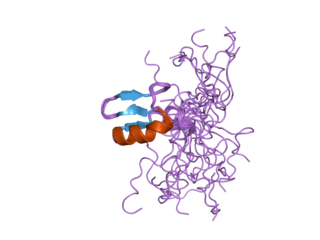Related Research Articles

Molecular genetics is a sub-field of biology that addresses how differences in the structures or expression of DNA molecules manifests as variation among organisms. Molecular genetics often applies an "investigative approach" to determine the structure and/or function of genes in an organism's genome using genetic screens. The field of study is based on the merging of several sub-fields in biology: classical Mendelian inheritance, cellular biology, molecular biology, biochemistry, and biotechnology. Researchers search for mutations in a gene or induce mutations in a gene to link a gene sequence to a specific phenotype. Molecular genetics is a powerful methodology for linking mutations to genetic conditions that may aid the search for treatments/cures for various genetics diseases.

Dystrophin is a rod-shaped cytoplasmic protein, and a vital part of a protein complex that connects the cytoskeleton of a muscle fiber to the surrounding extracellular matrix through the cell membrane. This complex is variously known as the costamere or the dystrophin-associated protein complex (DAPC). Many muscle proteins, such as α-dystrobrevin, syncoilin, synemin, sarcoglycan, dystroglycan, and sarcospan, colocalize with dystrophin at the costamere. It has a molecular weight of 427 kDa

Duchenne muscular dystrophy (DMD) is a severe type of muscular dystrophy that primarily affects boys. Muscle weakness usually begins around the age of four, and worsens quickly. Muscle loss typically occurs first in the thighs and pelvis followed by the arms. This can result in trouble standing up. Most are unable to walk by the age of 12. Affected muscles may look larger due to increased fat content. Scoliosis is also common. Some may have intellectual disability. Females with a single copy of the defective gene may show mild symptoms.

Zinc finger protein GLI2 also known as GLI family zinc finger 2 is a protein that in humans is encoded by the GLI2 gene. The protein encoded by this gene is a transcription factor.

Zinc finger protein GLI3 is a protein that in humans is encoded by the GLI3 gene.

A reeler is a mouse mutant, so named because of its characteristic "reeling" gait. This is caused by the profound underdevelopment of the mouse's cerebellum, a segment of the brain responsible for locomotion. The mutation is autosomal and recessive, and prevents the typical cerebellar folia from forming.

Lamin B2 is a protein that in humans is encoded by the LMNB2 gene. It is the second of two type B nuclear lamins, and it is associated with laminopathies.

Myosin VIIA is protein that in humans is encoded by the MYO7A gene. Myosin VIIA is a member of the unconventional myosin superfamily of proteins. Myosins are actin binding molecular motors that use the enzymatic conversion of ATP - ADP + inorganic phosphate (Pi) to provide the energy for movement.

Chromodomain-helicase-DNA-binding protein 7 also known as ATP-dependent helicase CHD7 is an enzyme that in humans is encoded by the CHD7 gene.
In molecular cloning and biology, a gene knock-in refers to a genetic engineering method that involves the one-for-one substitution of DNA sequence information in a genetic locus or the insertion of sequence information not found within the locus. Typically, this is done in mice since the technology for this process is more refined and there is a high degree of shared sequence complexity between mice and humans. The difference between knock-in technology and traditional transgenic techniques is that a knock-in involves a gene inserted into a specific locus, and is thus a "targeted" insertion. It is the opposite of gene knockout.

Dentatorubral–pallidoluysian atrophy (DRPLA) is an autosomal dominant spinocerebellar degeneration caused by an expansion of a CAG repeat encoding a polyglutamine tract in the atrophin-1 protein. It is also known as Haw River Syndrome and Naito–Oyanagi disease. Although this condition was perhaps first described by Smith et al. in 1958, and several sporadic cases have been reported from Western countries, this disorder seems to be very rare except in Japan.

A genetically modified mouse or genetically engineered mouse model (GEMM) is a mouse that has had its genome altered through the use of genetic engineering techniques. Genetically modified mice are commonly used for research or as animal models of human diseases, and are also used for research on genes. Together with patient-derived xenografts (PDXs), GEMMs are the most common in vivo models in cancer research. Both approaches are considered complementary and may be used to recapitulate different aspects of disease. GEMMs are also of great interest for drug development, as they facilitate target validation and the study of response, resistance, toxicity and pharmacodynamics.
Scrambler is a spontaneous mouse mutant lacking a functional DAB1 gene, resulting in a phenotype resembling that seen in the reeler mouse. The strain was first described by Sweet et al. in 1996.

Jacqueline N. Crawley is an American behavioral neuroscientist and an expert on rodent behavioral analysis. Since July 2012, she is the Robert E. Chason Chair in Translational Research in the MIND Institute and professor of psychiatry and behavioral sciences at the University of California, Davis School of Medicine in Sacramento. Previously, from 1983–2012, she was chief of the Laboratory of Behavioral Neuroscience in the intramural program of the National Institute of Mental Health. Her translational research program focuses on testing hypotheses about the genetic causes of autism spectrum disorders and discovering treatments for the diagnostic symptoms of autism, using mouse models. She has published more than 275 peer-reviewed articles in scientific journals and 110 review articles and book chapters. According to Scopus, her works have been cited over 36,000 times, giving her an h-index of 99. She has co-edited 4 books and is the author of What's Wrong With my Mouse? Behavioral Phenotyping of Transgenic and Knockout Mice, which was very well received.

Glutaredoxin domain-containing cysteine-rich protein 1 is a protein that in humans is encoded by the GRXCR1 gene.

ZZ-type zinc finger-containing protein 3 is a protein that in humans is encoded by the ZZZ3 gene.

The International Mouse Phenotyping Consortium (IMPC) is an international scientific endeavour to create and characterize the phenotype of 20,000 knockout mouse strains. Launched in September 2011, the consortium consists of over 15 research institutes across four continents with funding provided by the NIH, European national governments and the partner institutions.
The Mouse Genetics Project (MGP) is a large-scale mutant mouse production and phenotyping programme aimed at identifying new model organisms of disease.

Steve David Macleod Brown is director of the Medical Research Council (MRC) Mammalian Genetics Unit, MRC Harwell at Harwell Science and Innovation Campus, Oxfordshire, a research centre on mouse genetics. In addition, he leads the Genetics and Pathobiology of Deafness research group.

ATP/GTP binding protein 1 is gene that encodes the protein known as cytosolic carboxypeptidase 1 (CCP1), originally named NNA1. Mice with a naturally occurring mutation of the Agtpbp1 gene are known as pcd mice.
References
- ↑ Hatcher JP, Jones DN, Rogers DC, et al. (November 2001). "Development of SHIRPA to characterise the phenotype of gene-targeted mice". Behav. Brain Res. 125 (1–2): 43–7. doi:10.1016/s0166-4328(01)00275-3. PMID 11682092. S2CID 6313756.
- 1 2 Nolan PM, Peters J, Strivens M, et al. (August 2000). "A systematic, genome-wide, phenotype-driven mutagenesis programme for gene function studies in the mouse". Nat. Genet. 25 (4): 440–3. doi:10.1038/78140. PMID 10932191. S2CID 9028853.
- 1 2 Rogers, D. C.; Fisher, E. M. C.; Brown, S. D. M.; Peters, J.; Hunter, A. J.; Martin, J. E. (1997). "Behavioral and functional analysis of mouse phenotype: SHIRPA, a proposed protocol for comprehensive phenotype assessment". Mammalian Genome. 8 (10): 711–713. doi:10.1007/s003359900551. PMID 9321461. S2CID 29864514.
- ↑ Rogers DC, Peters J, Martin JE, et al. (June 2001). "SHIRPA, a protocol for behavioral assessment: validation for longitudinal study of neurological dysfunction in mice". Neurosci. Lett. 306 (1–2): 89–92. doi:10.1016/S0304-3940(01)01885-7. PMID 11403965. S2CID 44756347.
- ↑ Lalonde R, Strazielle C (May 2021). "SHIRPA as a neurological screening battery in mice". Current Protocols. 1 (5): 482–488. doi:10.1002/cpz1.135. PMID 4000103. S2CID 234770535.
- ↑ Rafael JA, Nitta Y, Peters J, Davies KE (September 2000). "Testing of SHIRPA, a mouse phenotypic assessment protocol, on Dmd(mdx) and Dmd(mdx3cv) dystrophin-deficient mice". Mamm. Genome. 11 (9): 725–8. doi:10.1007/s003350010149. PMID 10967129. S2CID 12996210.
- ↑ Lalonde R, Eyer J, Wunderle V, Strazielle C (May 2003). "Characterization of NFH-LacZ transgenic mice with the SHIRPA primary screening battery and tests of motor coordination, exploratory activity, and spatial learning". Behav Proc. 63 (1): 9–19. doi:10.1016/S0376-6357(03)00013-5. PMID 12763264. S2CID 2508969.
- ↑ Lalonde R, Dumont M, Staufenbiel M, Strazielle C (February 2005). "Neurobehavioral characterization of APP23 transgenic mice with the SHIRPA primary screen". Behav. Brain Res. 157 (1): 91–8. doi:10.1016/j.bbr.2004.06.020. PMID 15617775. S2CID 35239762.
- ↑ Jacquelin C, Strazielle C, Lalonde R (September 2011). "Neurologic function during developmental and adult stages in Dab1(scm) (scrambler) mutant mice". Behav. Brain Res. 226 (1): 265–273. doi:10.1016/j.bbr.2011.09.020. PMID 21945093. S2CID 140205214.
- ↑ Masuya H, Inoue M, Wada Y, et al. (November 2005). "Implementation of the modified-SHIRPA protocol for screening of dominant phenotypes in a large-scale ENU mutagenesis program". Mamm. Genome. 16 (11): 829–37. doi:10.1007/s00335-005-2430-8. PMID 16284798. S2CID 35870158.